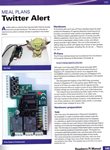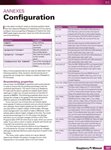
Introduction
To be honest, I had heard of this book, but had never looked at, researched it, or had any desire to own it. However, during a trip to a local bookstore to look for some other books for my youngest daughter, I thought while I was there I might as well go and see what computing books they had on the shelf.
While scanning the shelves of the limited selection which appeared to be more focused towards Windows 8, Microsoft Office, iPads and Tablets etc. there sat next to some Python books was this hardback book calling out my name.
Picking up the book and opening the pages instantly grabbed my attention.......sold I was.
I also flashed back to only the night before when my eldest daughter had mentioned they were going to be getting let loose on the Raspberry Pi at school in a year or so, and she had already shown an interest in the device (as well as others like Arduino) that I have also lying around my home office, so she may benefit from it.
Oh, and just in case you were wondering, the books I actually went into look for were "Harry and his Bucketful of Dinosaurs"....slight contrast. 
Background
Well in case you haven't worked it out yet, this book is dedicated to the Raspberry Pi and is written in the style of a Haynes Workshop Manual that many of you have probably owned at one point in your life, probably during your early motoring years because you needed to fix your car, and not forgetting that the 'internet' or 'google' hadn't been invented yet!
About the book
The book is a hardback edition, 176 pages first published March 2013, and is a full colour presentation. The book is packed full of colourful glossy images, code snippets, screenshots, pinouts.
Broken down to 7 chapters covering everything you would really need to get you going with a Raspberry Pi.
Chapter 1 - Introduction
 | This is a very quick, as in only 4 pages into the how the Raspberry Pi came to be, how the computing industry evolved from room filled computer, to the BBC Micro and onto the Raspberry Pi project. |
Chapter 2 - A Quick Bite
 | This chapter is where things really start to get going. Whether you are a Windows User or a Linux User, you will be taken through the process of imaging an SD Card using an appropriate download to get the Raspberry Pi up and running. The chapter will take you through the various connectors on the Raspberry Pi, how to configure the board for different keyboards, timezones and even expanding the file system or adjusting the memory split between the GPU and the main processor. |
Chapter 3 - How To Cook
 | Starting off with an introduction to programming languages followed by an introduction to operating systems, Chapter 3 then expands into an introduction to Python covering the basics and a few example programs. The chapter finishes off with an introduction to Linux and the basic commands that you may require for manipulating the files system, installing packages or shutting down and rebooting. |
Chapter 4 - Software Recipes
 | Following an overview of Cron jobs and web page scrapping, the chapter moves into internet territory, talking about protocols, DNS, setting up sockets etc. The next few sections cover Access via Serial lines, SSH, X Windows and then a piece on creating a Web Server. The final sections in this chapter cover Network Shares using Samba and then remote access via VNC or Remote Desktop. |
Chapter 5 - Hardware Recipes
 | As you can guess, this chapter starts to move into hardware territory, looking at USB hubs, memory sticks, optical drives and WIFI adapters as well as using Bluetooth adapters. The chapter then moves into controlling the 5 LEDS on the Raspberry Pi board before heading into the world of the GPIO connectors. The chapter also discusses making connections to SPI devices as well as I2C devices and finally onto using the UART pins. The last section of this chapter briefly covers varying power options, i.e. using battery backs, DC-DC converters and off-the-shelf power packs and the power requirements of the Raspberry Pi and loadings. |
Chapter 6- Meal Plans
 | In this chapter the authors take a look at using the Raspberry Pi as an MP3 server using Edna. This then moves into gaming on the board, and writing a Snake program in Python. The chapter also introduces the Pi-Face board and writing a Twitter Alert system. The finale to this chapter is looking at the Raspberry Pi as a media centre using XMBC. |
Chapter 7 - Annexes
 | The last chapter of the book looks at various configuration options available on the Raspberry Pi, even overclocking the BCM2835 SoC. There a tables of parameters detailing what everything is for, how to boot into Safe Mode and even tweak the file system. Lastly, the chapter looks at some of the multimedia libraries used with the Raspberry Pi. |
In Summary
The book is a well structured, colourful manual that meets the needs of a novice. Even having owned a couple of Raspberry Pis for over a year now, I certainly believe that I will be referring to it. particularly the GPIO info.
Availability
The book is available at;
Amazon: http://www.amazon.co.uk/Raspberry-Pi-Manual-practical-revolutionary/dp/0857332953 and probably from many other book sources.
History
5th March 2014 - First Release
 General
General  News
News  Suggestion
Suggestion  Question
Question  Bug
Bug  Answer
Answer  Joke
Joke  Praise
Praise  Rant
Rant  Admin
Admin 






